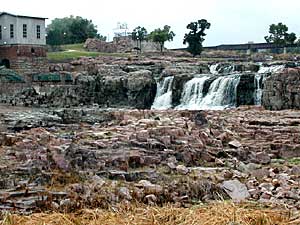|
Audio
Photos
Resources
Your Voice
|
Big Sioux River drying up
September 9, 2003
It rained in Sioux Falls Tuesday -- a rare occurrence this summer. But one day's worth of showers won't be enough to help solve the city's water problems. That's because the Big Sioux River, the city's main source for drinking water, is drying up.
Sioux Falls, S.D. — City officials are prepared to put a total watering ban in place this Thursday. The mayor has already told the Parks Department to stop watering park lawns and golf courses. Right now, Sioux Falls residents can water lawns once a week. The restrictions change almost weekly, as the Big Sioux River runs dry.
The Big Sioux River flows into Sioux Falls from the north and drains into the Missouri River to the south. It's the main source of drinking water for Sioux Falls, which is the only city that relies on the river as its water source.
 | |||
Public Works Director Lyle Johnson says the river is not flowing right now -- it's trickling.
"In fact, it pretty much stops at the north end of Sioux Falls. And what you see going down the falls is pretty much from Skunk Creek flows, which is downstream from our intake. So the flow going over the falls is not coming from the north, it's coming from the west," says Johnson.
Sioux Falls uses 22 million gallons of water on an average day. In the summer, it's double that and all of the extra usage is for watering lawns.
Johnson says normal household water use isn't in jeopardy, but only if people stop watering their lawns.
"In the last few years, when we've had warm, dry winters, people have been watering all the way into December. And we've had to adjust sewer bills because of the amount of lawn watering that's gone on in November and December," says Johnson. "Green lawns are very important to some people, and they continue to water as long as nature allows them to."
 | |||
The city is offering incentives for residents to conserve water. One incentive is a water conservation kit. The kit includes a lower-flow shower head; a hose nozzle with an automatic shutoff; and a measuring cup. That's to stick into your grass to measure how much water your lawn is getting. The city recommends only an inch of water a week.
The city is also paying people to replace appliances that use a large amount of water. Residents get $75 when they install in a water-efficient toilet, and $150 if they buy a new, more efficient, washing machine.
Johnson says the city budgeted $50,000 for the new program, but in its first year, the city has already sent out five times that. But Johnson says it's money well spent.
"We continue to do it and we're not going to stop, because every bit of water we save -- that's helping us down the line. It's extending the life of our water supply out there, so we don't need a supplemental supply maybe as early as we thought," says Johnson.
 | |||
Sioux Falls is growing fast enough that its current water supply won't keep up. Sioux Falls is projected to run out of water in nine years.
But there are plans for a new water source -- the Lewis and Clark Rural Water System. The pipeline will distribute water from the Missouri River to 30 communities, including 10 million gallons per day to Sioux Falls. Johnson says people will still have to conserve.
"So we're still reliant on the Big Sioux River and we're still reliant on the aquifer. So those that look at the pipeline and say, 'Good, there won't be any more watering restrictions,' no, no that's not the case," says Johnson. "There's going to be plenty of water to go about your normal daily life, but the one thing that will have to suffer is irrigation."
In the short term, Johnson says the area needs at least six inches of rain within a 48-hour period to bring the river back up to a safe level. And he says it could be just as bleak next spring. The only things that will help are good rains this fall, and lots of snow this winter.
|
News Headlines
|
Related Subjects
|

